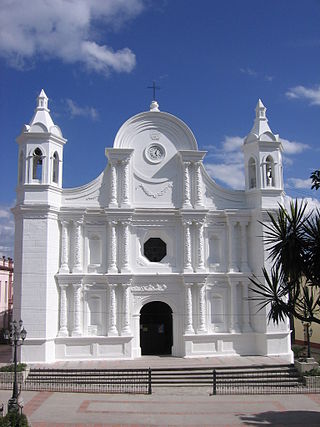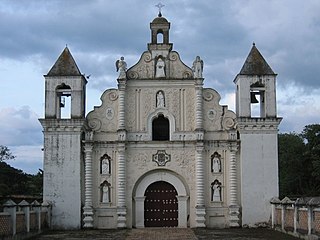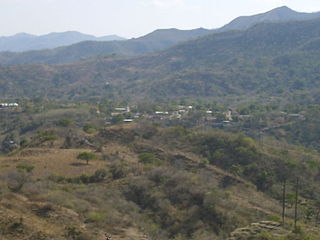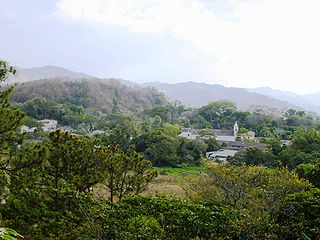
Honduras is divided into 18 departments. Each department is headed by a governor, who is appointed by the President of Honduras. The governor represents the executive branch in the region in addition to acting as intermediary between municipalities and various national authorities; resolves issues arising between municipalities; oversees the penitentiaries and prisons in his department; and regularly works with the various Secretaries of State that form the President's Cabinet. To be eligible for appointment as a governor, the individual must: a) live for five consecutive years in the department; b) be Honduran; c) be older than 18 years of age and; d) know how to read and write.

Copán is one of the departments in the western part of Honduras. The departmental capital is the town of Santa Rosa de Copán. The department is well known for its tobacco and fine cigars.

Lempira is one of the 18 departments in Honduras. located in the western part of the country, it is bordered by the departments of Ocotepeque and Copán to the west, Intibucá to the east, and Santa Bárbara to the north. To its south lies the El Salvador–Honduras border. The departmental capital is Gracias.

Santa Rosa de Copán is a municipality in Honduras. The city of Santa Rosa de Copán is the municipal seat and the departmental capital of the Honduran department of Copán. It is located approximately 1,150 metres (3,773 ft) above mean sea level.

Gracias is a small Honduran town/municipality that was founded in 1536, and is the capital of Lempira Department.
La Esperanza is the capital city and a municipality of the same name of the department of Intibucá, Honduras. La Esperanza is famous for having the coolest climate in Honduras. It is considered the heart of the Ruta Lenca, a region of Lenca ethnic influence that spans Honduras from Santa Rosa de Copan to Choluteca. Sites on the Lenca Trail have been designated by the government and United Nations development in order to encourage more cultural tourism, and help create new markets for the traditional crafts, such as pottery, practiced by the Lenca, in order to preserve their culture.

Victoriano Castellanos Cortes (1795–1862) was President of Honduras from 4 February 1862 to 4 December 1862.

Las Flores is a municipality in the Honduran department of Lempira.

La Virtud is a municipality in the Honduran department of Lempira.

Lepaera is a municipality in the Honduran department of Lempira. It has tropical climate all year round.

Tambla is a municipality in the Honduran department of Lempira.

Liga de Ascenso is the second division of Honduran football; it was founded on 17 December 1979 as Segunda División and renamed Liga de Ascenso on 21 July 2002. The league is divided into 4 groups: Zona Norte y Atlántica, Zona Norte y Occidente, Zona Centro y Sur, Zona Sur y Oriente. The top 2 teams of each group qualifies for the liguilla (play-offs). Each season is divided into two tournaments, Apertura (opening) and Clausura (closing). The champions of the opening and closing tournament compete for the promotion to Liga Nacional de Fútbol de Honduras in a two-legged match.

Deportes Savio Fútbol Club, commonly known as Deportes Savio, is a professional Honduran football club based in Santa Rosa de Copán. The club was founded in 1974, and participates in the Liga Nacional de Fútbol Profesional de Honduras. In 2006–07 they achieved the promotion to the top league of the Honduran League.

Argentina Díaz Lozano was the pseudonym for the Honduran writer Argentina Bueso Mejía. She was a journalist and novelist, who wrote in the romantic style with feminist themes. She won numerous awards for her books, including the Golden Quetzel from Guatemala, the Honduran National Literature Prize Ramón Rosa" and the "Order Cruzeiro do Sud" from Brazil. She was admitted to the Academia Hondureña de la Lengua and is the only Central American woman whose work has officially contended for a Nobel Prize for Literature.

Marlon Tábora Muñoz is a Honduran politician and diplomat, a PhD in economic sciences, and a member of the National Party of Honduras. Previously Tábora has been Honduras Ambassador to the United States and also worked as Executive Director for Central América and Belize at the Inter-American Development Bank and Counselor Minister of Economic and Energy Affairs of the President Juan Orlando Hernández
Grupo Continental is a Honduran conglomeration of businesses founded in 1929 and owned by the Rosenthal family, headed by Jaime Rosenthal. In October 2015 the Grupo was accused of supporting drug trafficking and money laundering.

St. Rose Cathedral, also called Santa Rosa de Copán Cathedral, is the main church of the Roman Catholic Diocese of Santa Rosa de Copán in the city of Santa Rosa de Copán in the Central American country of Honduras. The church is dedicated to St. Rose of Lima.

The San Cristóbal fortress is located in the city of Gracias, department of Lempira, built on a small hill above the city, which was formerly the center of the town of Gracias Lempira, which was once the capital of New Spain and headquarters of the Real Audiencia de los Confines in 1544; Gracias was a strategic city within the Province of Honduras in the colonial era, then in the pro-independence era and then in the Central American federal transition.
The First Honduran Civil War or Revolution of 19 was an armed conflict that took place in the Republic of Honduras in 1919. This was the first conflict in Honduran soil where the weapons and technological advances of the 20th century were felt.














